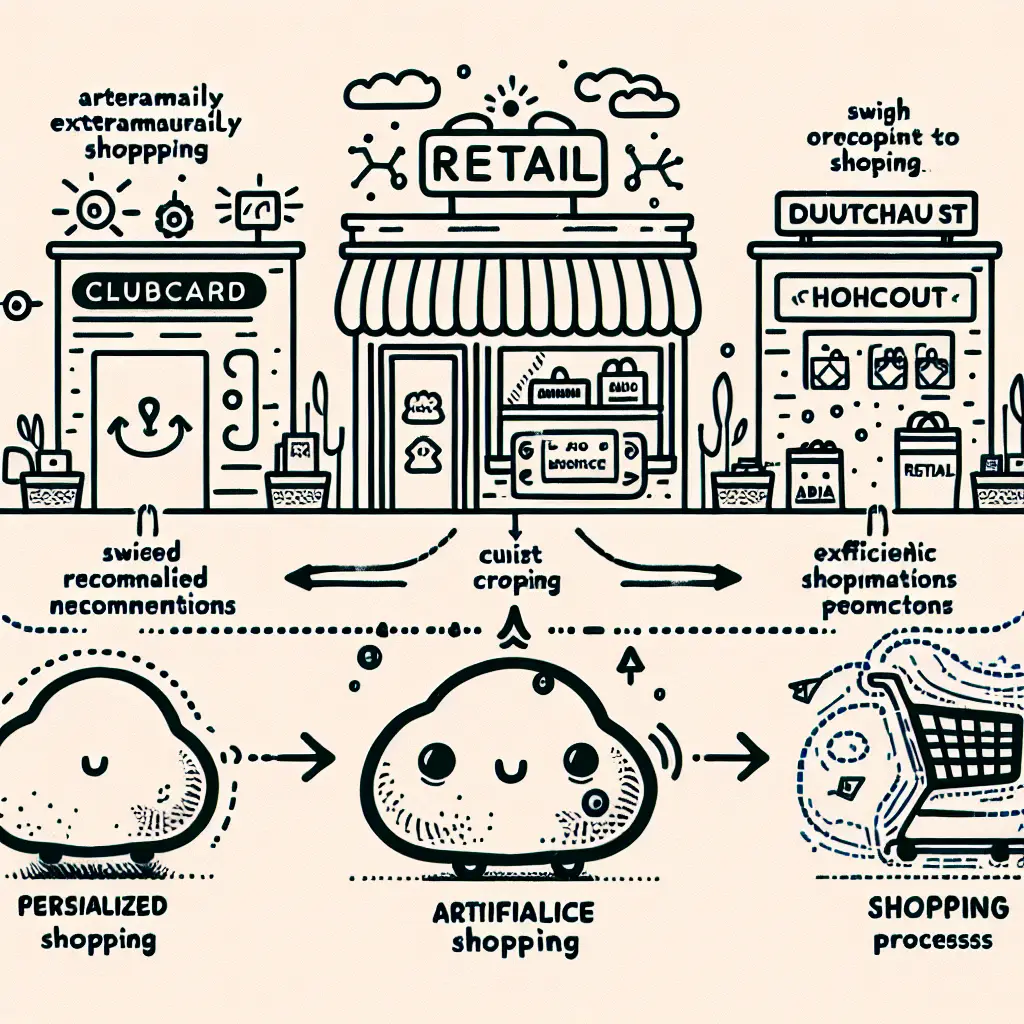
Brief history of AI technology in retail
AI technology in retail has evolved significantly over the past few decades. In the early stages, AI was primarily focused on data analysis and basic automation tasks. Systems were developed to optimize inventory management and streamline supply chain operations. As technology advanced, retailers began to adopt machine learning algorithms to enhance customer experiences, such as personalized recommendations and dynamic pricing strategies. For more insights, visit our post on AI-Driven Innovations in Supply Chain.
Current state of AI adoption in e-commerce
Today, AI is deeply integrated into e-commerce platforms. Retailers utilize AI for various applications, including chatbots for customer service, predictive analytics for inventory forecasting, and image recognition for product searches. According to recent studies, over 75% of retailers are now implementing AI technologies to improve operational efficiency and enhance customer engagement. This shift signifies a broader acceptance of AI as an essential component of modern retail strategy. For a deeper dive into how AI is enhancing customer experience, check our article on The Impact of AI on Customer Engagement.
Purpose of the Article
The purpose of this article is to explore the multifaceted role of AI in modern retail. We aim to examine consumer attitudes towards AI technologies and analyze current industry trends that are shaping the retail landscape.

Understanding Consumer Attitudes Towards AI
Survey Insights on AI Acceptance
Recent surveys indicate a growing comfort among consumers with the use of AI in retail. Notably, 34% of U.S. consumers are willing to let AI make purchases on their behalf (source). This reflects a shift in consumer attitudes as they become more familiar with AI technologies and their applications in shopping. For a comprehensive understanding of AI acceptance trends, see our post on Consumer Behavior Trends in AI.
Preferences in Decision-Making
Despite this acceptance of AI, 66% of consumers still prefer to make their own purchasing decisions. This preference suggests that while consumers are open to AI assistance, they value personal agency in the decision-making process. Factors influencing these preferences for AI assistance include trust in AI recommendations, perceived accuracy, and the desire for personalized shopping experiences.

Benefits of AI in Retail
Personalization and Customer Experience
- 38% of consumers appreciate personalized recommendations.
- A notable example of AI-driven personalization is Tesco’s use of its Clubcard, which tailors shopping experiences to individual customer preferences (source).
For more on personalization technology, see our post on Enhancing Customer Experience with AI.
Efficiency in Shopping Processes
- 31% of consumers value faster shopping processes.
- The impact of AI is evident in online holiday sales performance, with a 4% increase in U.S. online holiday sales attributed to AI influence (source).

Data Privacy and Ethical Concerns
Consumer Worries about Data Handling
Over 50% of consumers express concern about the mishandling of their personal data by businesses. This significant percentage highlights the increasing awareness and apprehension surrounding data privacy in the digital age. Additionally, 28% of consumers report feeling distrustful of companies’ data practices, indicating a growing skepticism about how their information is collected, stored, and used. Such concerns can impact consumer behavior and loyalty, making it crucial for retailers to address these issues proactively. For more on data concerns, see our article on Navigating Data Privacy in Retail.
The Importance of Transparency
To maintain and foster consumer trust, retailers must prioritize transparency in their data handling practices. Recommendations for achieving this include:
- Clearly communicating what data is collected and how it will be used.
- Providing consumers with easy access to their data and options to manage their privacy settings.
- Regularly updating privacy policies to reflect current practices and regulatory requirements.
By implementing these measures, retailers can build trust and reassure consumers that their data is being handled responsibly.

Challenges Faced by AI in Retail
Issues with AI Recommendations
AI recommendations can often lead to frustrations among consumers due to inaccuracies. When customers rely on AI-driven suggestions, they expect personalized and relevant options. However, if the recommendations do not align with their preferences or needs, it can result in dissatisfaction and a loss of trust in the technology. This is particularly evident in scenarios where consumers receive irrelevant product suggestions, which can detract from the overall shopping experience.
Additionally, challenges arise in chatbot interactions and customer service. While chatbots are designed to streamline communication and provide quick responses, they can sometimes fail to understand customer inquiries accurately. This can lead to miscommunication, further frustrating customers who seek immediate assistance. For further information on AI in customer service, see our publication on AI Chatbots: Enhancing Customer Interaction.
Balancing Automation and Human Touch
Research indicates that nearly half of consumers prefer improved service quality over automation. This preference highlights the importance of maintaining a human touch in retail interactions. While AI can enhance efficiency and provide valuable insights, many customers still value the personalized service that only human representatives can offer. Striking a balance between leveraging AI for operational efficiency and ensuring that customers feel valued through human engagement is crucial for retailers aiming to enhance their customer experience.

The Future of AI in Retail
Innovations and R&D
AI is playing a crucial role in accelerating retail innovation and product development. By leveraging advanced algorithms and machine learning, retailers can streamline their processes and bring new products to market faster than ever before (source). Furthermore, AI enhances market research by analyzing vast amounts of consumer data, allowing for more informed design decisions and tailored customer experiences. For more on AI innovations, see our report on Future Trends in Retail Technology.
Operational Efficiency Gains
The implementation of AI in retail has shown significant potential for improving operational efficiency. Research indicates that AI can reduce operational inefficiencies by 40%, leading to substantial cost savings for retailers. Moreover, automation of 55% of back-office processes can free up valuable resources, allowing staff to focus on more strategic tasks (source). Additionally, logistics efficiency can see improvements of 32%, enhancing the overall supply chain performance.

Strategies for Successful AI Integration
Prioritize transparency in AI usage: Retailers should ensure that customers are aware of how AI is being used in their shopping experience. This includes informing them about data collection practices and how AI influences product recommendations.
Retain customer control over purchasing decisions: It is crucial for retailers to allow customers to make the final decisions in their purchasing journey. AI should assist, not dictate, consumer choices, empowering customers to feel confident in their decisions.
Effectively communicate the benefits of AI to consumers: Retailers need to articulate the advantages of AI, such as personalized shopping experiences and improved customer service. Clear communication can build trust and encourage acceptance of AI technologies.
Future-Proofing Retail with AI
Emphasizing continuous improvement and adaptation: Retailers should adopt a mindset of ongoing enhancement in their AI systems. This involves regularly updating algorithms and practices to keep pace with changing consumer preferences and technological advancements.
Investing in training for staff to work alongside AI tools: As AI becomes more integrated into retail operations, it is essential to train staff to effectively collaborate with these technologies. This ensures that employees can leverage AI capabilities while maintaining a human touch in customer interactions.

Conclusion
The integration of AI in modern retail has fundamentally transformed how businesses operate and engage with consumers. Key points discussed include the enhancement of customer experience through personalized recommendations, the optimization of inventory management, and the efficiency gains in supply chain logistics. Retailers leveraging AI technologies have been able to analyze vast amounts of data to make informed decisions, leading to improved sales and customer satisfaction.
Looking to the future, the landscape of AI in retail is poised for further evolution. As AI technologies continue to advance, we can expect even more innovative applications, such as augmented reality shopping experiences and advanced predictive analytics. This ongoing transformation will likely lead to a more seamless interaction between retailers and consumers, marking a significant shift in the retail paradigm.



